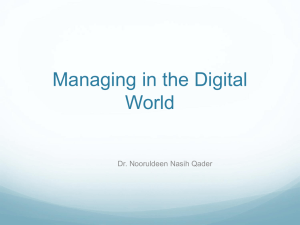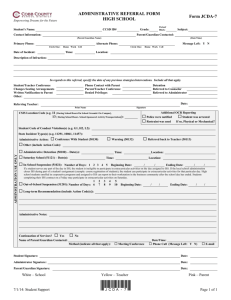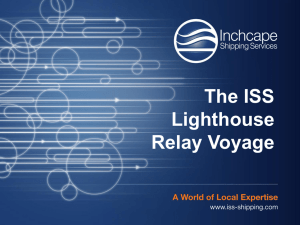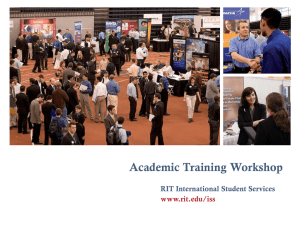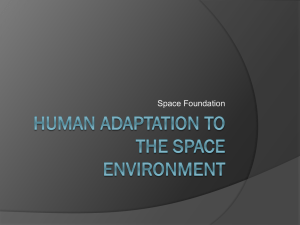Introduction to ISS Mission Control
advertisement
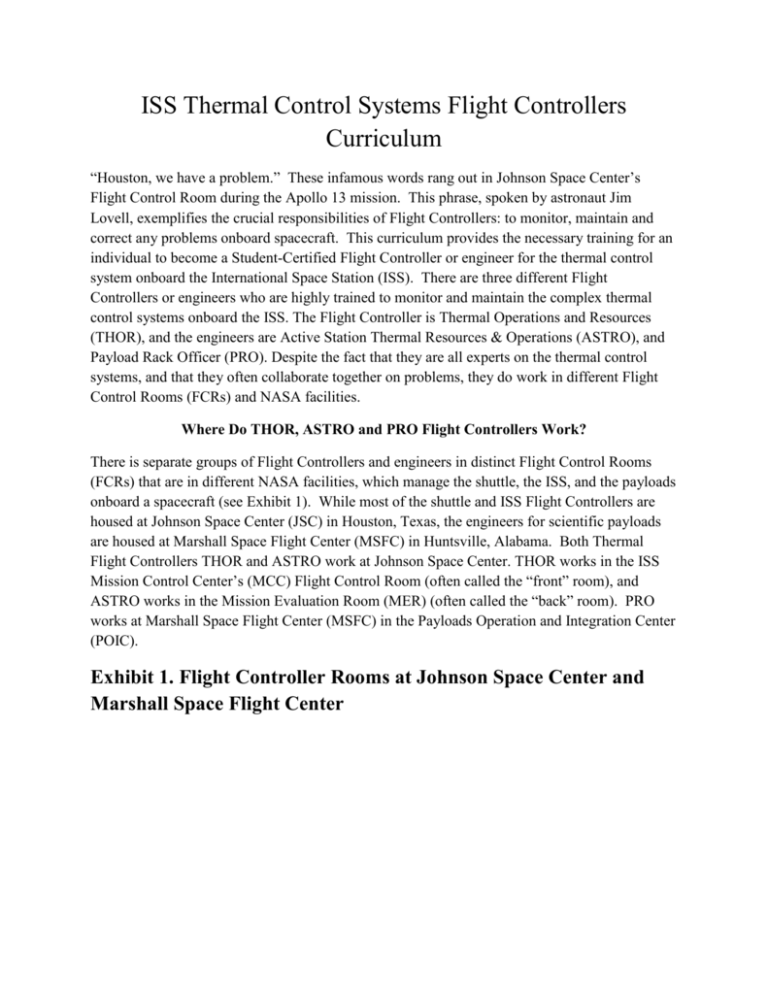
ISS Thermal Control Systems Flight Controllers Curriculum “Houston, we have a problem.” These infamous words rang out in Johnson Space Center’s Flight Control Room during the Apollo 13 mission. This phrase, spoken by astronaut Jim Lovell, exemplifies the crucial responsibilities of Flight Controllers: to monitor, maintain and correct any problems onboard spacecraft. This curriculum provides the necessary training for an individual to become a Student-Certified Flight Controller or engineer for the thermal control system onboard the International Space Station (ISS). There are three different Flight Controllers or engineers who are highly trained to monitor and maintain the complex thermal control systems onboard the ISS. The Flight Controller is Thermal Operations and Resources (THOR), and the engineers are Active Station Thermal Resources & Operations (ASTRO), and Payload Rack Officer (PRO). Despite the fact that they are all experts on the thermal control systems, and that they often collaborate together on problems, they do work in different Flight Control Rooms (FCRs) and NASA facilities. Where Do THOR, ASTRO and PRO Flight Controllers Work? There is separate groups of Flight Controllers and engineers in distinct Flight Control Rooms (FCRs) that are in different NASA facilities, which manage the shuttle, the ISS, and the payloads onboard a spacecraft (see Exhibit 1). While most of the shuttle and ISS Flight Controllers are housed at Johnson Space Center (JSC) in Houston, Texas, the engineers for scientific payloads are housed at Marshall Space Flight Center (MSFC) in Huntsville, Alabama. Both Thermal Flight Controllers THOR and ASTRO work at Johnson Space Center. THOR works in the ISS Mission Control Center’s (MCC) Flight Control Room (often called the “front” room), and ASTRO works in the Mission Evaluation Room (MER) (often called the “back” room). PRO works at Marshall Space Flight Center (MSFC) in the Payloads Operation and Integration Center (POIC). Exhibit 1. Flight Controller Rooms at Johnson Space Center and Marshall Space Flight Center What are the Responsibilities of Flight Controllers at MCC? Since 1998, Flight Controllers have been on duty 24 hours a day, 365 days a year in the Flight Control Room for the ISS. Their task is to keep a constant watch on all the systems onboard the ISS, in order to insure the safety of the crew and station. The Flight Controllers are equipped with some of the most sophisticated communication systems and computer equipment, in order for them to deal with any potential problems onboard the ISS, as quickly and efficiently as possible. Flight Controllers are responsible for a variety of tasks, ranging from monitoring the ISS trajectory to the onboard station temperatures. In fact, NASA’s ISS Flight Control Room at Mission Control Center is organized into twenty different consoles, each representing ongoing tasks needed to operate the ISS successfully in space. These consoles are managed by highly trained Flight Controllers, who specialize in the specific tasks indicated by their console’s name. The many systems onboard the ISS must work together to keep the station operational. It is important for Flight Controllers to know each other’s responsibilities. Exhibit 2 provides a list of the ISS Flight Controllers who manage the twenty consoles in MCC. Their NASA call signs and a very brief description of their position responsibilities are listed in the table. For more interactive information about the twenty Flight Controllers visit the web site http://www.spaceflight.nasa.gov/shuttle/reference/mcc/index.html. Exhibit 2. ISS Mission Control Center (MCC) Flight Controller Call Signs Responsibilities on ISS Flight Director Flight Oversees team of Flight Controllers Communication and Tracking CATO Manages on-orbit communications & telemetry Onboard Data and Information Network ODIN Manages computer hardware & software Environmental Control and Life Support Systems ECLSS Manages cabin air supply, humidity, and temperature, along with other systems that influence the station’s environment Power, Heating, Articulation, Lighting, and Control PHALON Manages the electricity to operate the station and its payloads Attitude Determination and Control ADCO Integrates guidance and navigation for the station using the Motion Control System and manages docking of spacecraft on ISS Thermal Operations and Resources THOR Manages the thermal control system, which regulates the dissipation of waste heat generated by equipment and payloads onboard the ISS Robotics Operations System ROBO Plans and executes robotic operations Extravehicular Activity EVA Responsible for all spacesuits and space walk activities Operation Support Officer OSO Manages all station maintenance activities that includes maintaining the mechanic systems for attachment of modules to the ISS Operation Planner Ops Plan Plans the station’s short-term crew schedules Assembly, Activation & Checkout Officer ACO Responsible for all new assembly for development of station and all checkout procedures Cargo Integration Officer CIO Assists in managing inventory of cargo that includes materials and equipment Trajectory Operations and Procedures Officer TOPO Manages station’s trajectory planning all orbital positions Visiting Vehicle Officer VVO Monitors visiting vehicles’ activities, while docking and undocking at the station Flight Surgeon (SURGEON)/ Biomedical Engineer BME Monitors and manages the health of the crew Ground Control GC Maintains Mission Control Center’s computers and coordinates the telemetry between MCC and the station Spacecraft Communicator CAPCOM The spokesperson for Mission Control Center to the crew on station Public Affairs Officer PAO Responsible to communicate to news media and the public the activities on station Payload Operations director at POIC POD POD oversees the team of Flight Controllers at MSFC, however he is directly responsible to MCC for the payloads onboard station What are the Responsibilities of the Engineers at Mission Evaluation Room (MER) The engineers in the Mission Evaluation Room are highly skilled and specialized engineers in a given system onboard the ISS. Their main duty is to back up the Flight Controllers in MCC with the details of their systems components, function, and configuration. If a MCC Flight Controller needs information to solve an anomaly, the MER engineer must be able to supply this information on a real time bases, because the safety of the ISS crew and station is dependent on their abilities. After the Columbia accident, the Mission Evaluation Room (MER), which previously housed both the ISS and shuttle engineers was broken up into two separate rooms. In October 12, 2004, the new shuttle MER room was dedicated allowing the ISS engineers ample room in the old MER. Who are THOR and ASTRO? The Flight Controller for the Thermal Control System in MCC is THOR, which stands for Thermal Operations and Resources. THOR is the Flight Controller that is responsible for the operation of the Thermal Control System (TCS) onboard the ISS. The Thermal Control System’s purpose is to maintain an appropriate temperature inside the ISS for both the crew and equipment, by removing waste heat generated by payloads and equipment onboard station. It involves a system of heaters, pumps, pipes, loops, radiators, sensors, valves, computers, Orbital Replaceable Units (ORU), and a lot more that will be discussed later. THOR also is responsible for the Thermal Control System outside the ISS. The TCS outside the ISS maintains temperatures for equipment on the surface of the ISS along with the proper dissipation of heat from the radiators on the surface of the ISS. The Thermal Control System console in the ISS Mission Evaluation Room (MER) is the Active Station Thermal Resources & Operations or ASTRO console. ASTRO’s counterpart in MCC is THOR. If an anomaly occurs involving the TCS on the ISS, the ASTRO engineer is ready to support THOR with detailed information on the operation of the Active Thermal Control System. There is also a Passive Thermal Control System (PTCS) engineer in MER to help THOR if there is an anomaly with the Passive Thermal Control System onboard the ISS. It is vital that ASTRO knows and understands all the systems on the ISS, not only the TCS, because problems do not occur in isolation. Therefore, ASTRO must be familiar with the other MER consoles, their call signs, and their responsibilities. Exhibit 3 lists MER consoles, call signs, and responsibilities. Exhibit 4 is a list of MCC consoles and their counter parts in MER. Exhibit 3. ISS Mission Evaluation Room (MER) Flight Controller Call Signs Responsibilities on ISS MER Manager MER Manager Oversees team of Flight Controllers in MER Command & Data Handling C&DH Manages computer hardware & software Communication and Tracking C&T Manages on-orbit communications & telemetry Configuration Management CM Crew Health Care System CHeCS Monitors and manages the health of the crew Mission Evaluation Room Life Support Integration MERLIN Manages cabin air supply, humidity, and temperature, along with other systems that influence the station’s environment Power Hardware, Operations, Electrical Networks, and Illuminating eXperts PHOENIX Manages the electricity to operate the station and its payloads Extravehicular and Crew Systems EV&CS Responsible for spacesuits and all space walk activities Extravehicular Activity EVA Responsible for all spacesuits and space walks activities Extravehicular Robotics EVR Plans and executes robotic operations Flight Crew Systems FCS Manages all station maintenance activities that includes maintaining the mechanic systems for attachment of modules to the ISS, assists in managing cargo inventory, and responsible for assembly and checkout procedures for station Guidance, Navigation & Control GN&C Integrates guidance and navigation for the station using the Motion Control System and manages docking of spacecraft Logistics & Maintenance L&M Manages all station maintenance activities that includes maintaining the mechanic systems for attachment of modules to the ISS, assists in managing cargo inventory, and responsible for assembly and checkout procedures for station MPLM NASA Element Management Officer MNEMO Operations Local Area Network Ops LAN Propulsion Prop Monitors visiting vehicles’ activities, while docking and undocking at the station Rendezvous, Proximity Ops, and Capture RPOC Monitors visiting vehicles’ activities, while docking and undocking at the station Structures & Maintenance S&M Manages all station maintenance activities that includes maintaining the mechanic systems for attachment of modules to the ISS Safety & Mission Assurance S&MA Passive Thermal Control System PTCS Manages the passive thermal control system, which helps to regulate the dissipation of waste heat generated by equipment and payloads Active Station Thermal Resources & Operations ASTRO Manages the active thermal control system, which regulates the dissipation of waste heat generated by equipment and payloads Vehicle Integrated Performance and Resources VIPER Responsible for assembly and checkout procedures for station and assists in managing inventory of cargo that includes materials and equipment Exhibit 4. MCC consoles and their MER counter parts MCC Console MER Counter Part Flight MER Manager CATO C&T ODIN C&DH ECLSS MERLIN PHALON PHOENIX ADCO GN&C, PROP THOR PTCS, ASTRO ROBO EVR EVA EVA, EV&CS OSO S&M, L&M, FCS Ops Plan No MER counter part ACO VIPER, L&M, FCS CIO VIPER, L&M, FCS, OPSLAN TOPO GN&C VVO GN&C, PROP, RPOC SURGEON (BME) CHeCS GC No MER counter part CAPCOM No MER counter part PAO No MER counter part What Are Payload Operations Integration Center’s (POIC) Responsibilities? The Payload Operations and Integration Center is located at Marshall Space Flight Center (MSFC) in Huntsville, Alabama. POIC oversees the science experiments that are called payloads onboard the ISS. As the ISS has expanded to three scientific laboratories, so has its payload capacity. At present, there are three fully functional laboratories with the capacity to contain 150 experiments. The US Destiny Laboratory was launched on the Endeavour Shuttle in February 2001. The European-built Columbus Module was launched on the Atlantis Shuttle in February 2008, and the Japanese-built Kibo Experiment Module arrived at the ISS in June 2008 onboard Discovery. All three laboratories contain racks for experiments. The engineers in POIC monitor these experiments and coordinate communications between the scientists on earth and the crew onboard the ISS. Who is PRO? There are seven consoles in POIC all of which have to do with managing the racks of scientific experiments in the Destiny Laboratory. These racks make up the payload or shipment of scientific experiments onboard the ISS. They are called ExPRESS racks. The PRO console is manned by the Payload Rack Officer (PRO), who manages the waste heat removal for the ExPRESS racks. ExPRESS racks generate waste heat that must be monitored and managed to prevent overheating that could cause damage to the experiments, crew, and station. If there is a problem on an ExPRESS rack that is affecting the TCS, PRO will coordinate efforts to fix this problem by consulting with THOR at MCC, ASTRO at MER, and the scientists responsible for the experiment on earth. Since all of the engineers at POIC deal with payloads, they must be knowledgeable about each others’ duties and responsibilities. Exhibit 5 is a list of the POIC engineers, their call signs, and responsibilities. For more information about the engineers at POIC visit the interactive web site at http://www.nasa.gov/mission_pages/station/science/payload_ops.html. For more information about the Destiny Laboratory, Columbus Module, and Kibo Experiment Module with videos of the laboratories visit the web site http://www.nasa.gov/externalflash/lab_racks/labs.html Exhibit 5. Payload Operations and Integration Center Flight Controller Call Signs Responsibilities on ISS Payload Operations Director POD Oversees team of Flight Controllers at POIC Operations Controller OC Manages crew work assignments for science experiments Payload Rack Officer PRO Manages the waste heat removal for science experiments Data Manager Coordinator DMC Manages data and videos transmission of science experiments to scientist on earth Payloads Communication Manager PAYCOM Communicates with the crew on ISS Lead Increment Scientist Representative LIS Rep Manages research status of payloads Shuttle Operations Coordinator SOC Manages scientific experiments while they are on shuttle The Thermal Control Systems Onboard the International Space Station What is the Active Thermal Control System (ATCS)? The ISS generates large amounts of waste heat during operations. This heat is a byproduct of the operation of equipment and scientific experiments onboard the ISS. Just like on earth, when electrical energy is used to run a machine, waste heat is given off according to the conservation of energy, which obeys the laws of thermodynamics. This waste heat must be rejected into space in order to maintain comfortable temperatures for the crew and prevent overheating of the equipment onboard the ISS. The Internal Active Thermal Control System (IATCS) uses large loops to circulate water within the ISS. These loops collect the waste heat generated by the equipment inside the ISS. The water in the loops collects the waste heat from equipment onboard the ISS. The water in the loops then transport the heat to the External Active Thermal Control System (EATCS), which consists of loops containing 100% anhydrous ammonia located on the exterior of the ISS. The external ammonia loops then reject the heat to outer space from radiators. The system is considered active because it uses mechanical systems to circulate the fluids within the loops. The process is made complicated because fluids and heat behave differently in microgravity environments. The present ATCS is new to the ISS. It recently became fully functional. It replaced the Early Active Thermal Control System that has been operating until now. With the full ATCS in place the ISS expands its capacity to support 6 astronauts along with a larger number of scientific experiments. What is the Internal Active Thermal Control System (IATCS)? There are two systems an internal and external system that makes up the ATCS. The internal loop is made up of systems of pipes in which water is circulated. Water is a good conductor of heat. As the water circulates throughout the interior of the ISS, it accumulates waste heat from the equipment. Water is used because it is not toxic or flammable. There are two internal loops, one for low temperatures (4.40 degrees Celsius) and one for moderate temperatures (17.2 degrees Celsius). These two loops can act independently or as a single loop. The system is set up so that when it is acting as a single loop it still maintains the difference in temperatures for the low temperature loop and the moderate temperature loop. Visually you can tell the two loops apart because the Low Temperature Loop (LTL) has insulation wrapped around it to prevent condensation of water, since the temperature of the loop is below the dew point. This insulation prevents condensation. The water transports its waste heat through the loops to the Interface Heat Exchangers (IFHX) located on the exterior of the station. The Interface Heat Exchangers transfers the heat from the internal water loops to the External Active Thermal Control System. Exhibit 6. Interface Heat Exchanger (IFHX) The Interface Heat Exchanger takes heated water and cool ammonia in and outputs cool water and heated ammonia. What is the External Active Thermal Control System (EATCS)? There are two independent loops on the External Active Thermal Control System (EATCS). Loop A is at the starboard side (right) of the ISS and its Interface Heat Exchanger connects to the Low Temperature Loop. Loop B is at the port side (left) of the ISS and its Interface Heat Exchanger connects to the Moderate Temperature Loop. Anhydrous ammonia is used in these external loops. Ammonia is used because of its extremely low freezing point of -77.2 degrees Celsius, at standard atmospheric pressure. This is important since when the ISS is not experiencing daylight, temperatures get extremely cold in space. Both loop A and B collect waste heat from five Interface Heat Exchangers (IFHX) and four coldplates that are externally mounted on the ISS. The coldplates are part of the externally mounted Main Bus Switching Units (MBSU) and the Direct Current-to Direct Current Converter Units (DDCU). The coldplates collect the waste heat generated from the MBSU and the DDCU so that they do not overheat and stop functioning. There are 2 Main Bus Switching Units (MBSU) and 2 Direct Current-to Direct Current Converter Units on loop A and B. The DDCU converts power and the MBSU distributes electricity to the interior and the exterior of the ISS. If a malfunction occurs within the DDCU or MBSU then electricity to the ISS is diminished. Electricity is needed to run heaters and Pump Modules (PM), that are components of the EATCS. Electrical heaters are wrapped around the external loops to maintain temperatures when the ISS is eclipsed by earth from the sun. Without these heaters the ammonia in the loops could freeze because temperatures outside the ISS go below the -77.2 degrees Celsius, the freezing point of ammonia. The Pump Modules control the flow of ammonia, which helps to regulate the temperature and pressure of ammonia inside the loops. Normal operating temperature in the loops is 2.7 degrees Celsius and normal operating pressure is 300 psia. A Pump & Control Valve Package (PCVP) contains the necessary components to regulate and monitor the temperature and pressure of the ammonia within the loops. Exhibit 7. Coldplate (Black Cushion) on Main Bus Switching Unit The Coldplate is the black cushion that sits on top of the MBSU to keep it cool. Ammonia runs through tunnels in the cold plate collecting waste heat from the MBSU. What do Radiators do on the EATCS? Radiators are used in the External Active Thermal Control System. The radiators are fully deployable and retractable along with the ability to swivel so that they can maximize heat rejection into space. It is through the radiators that waste heat from the ISS is rejected into space. The radiators are attached to Radiator Beams, which are attached to one of the ISS Truss sections by the Thermal Radiator Rotary Joint (TRRJ), which rotates to allow for Radiator Beam rotation of 104 degrees (See Exhibit 8, 9, &10). When the radiators are in sunshine they are turned with their edges toward the sun to maximize heat radiation away from the radiators into space. When the earth eclipses the ISS from the sun the radiators are turned face to earth to receive some of the earth’s warmth so that the radiators do not freeze. The direction and deployment of the radiators is controlled by the Thermal Control System Software, which is an intricate computer program that monitors temperatures within the radiators. The radiators are located on the Integrated Truss Assembly, which provides the structures to attach and link together the many components and modules of the ISS. Radiators are located on Truss T1 and S1 that are on either side of the center Truss T0, where Destiny Lab is located. There are 12 Truss segments in all that when combine make up the Integrated Truss Assembly which provides the structural design of the ISS. The web site http://www.nasa.gov/externalflash/ISSRG/pdfs/integrated.pdf has an excellent picture of the Integrated Truss Assembly structures. Exhibit 8. Expanded Radiator Exhibit 9. Thermal Radiator Rotary Joint (TRRJ) Exhibit 10. Truss S1 or P1 Exterior Truss S1 or P1 showing location of 3 radiators that are not deployed, 6 Radiator Beam Valve Modules, and an Ammonia Tank Assembly. Controls: In order to maintain the correct amount of ammonia, at the appropriate temperature and pressure the EATCS employs several control assemblies. First, there is the Ammonia Tank Assembly (ATA). The ATA consists of two ammonia tanks whose pressure is controlled by a Nitrogen Tank Assembly (NTA). The NTA consist of nitrogen under high pressure so that it can efficiently control the pressure of the ammonia in the ATA. Ultimately, the NTA regulates the pressure of the ammonia in the loops. Ammonia’s pressure in the ATA is increased or decreased by regulating how much pressure the NTA exerts on the ATA. This nitrogen pressure moves the ammonia into the loops and keeps it circulating. Fri, 09 Apr 2010 03:32:40 -0500 STS-131 spacewalkers Rick Mastracchio and Clayton Anderson disconnected ammonia and nitrogen fluid lines from a spent Ammonia Tank Assembly (ATA). The old ATA will be removed from the International Space Station’s starboard truss during the mission's second spacewalk. Mastracchio and Anderson also removed bolts that held the replacement ATA in Discovery’s payload bay, then handed the new assembly to the space station robotic arm, operated by Pilot James P. Dutton Jr. and Mission Specialist Stephanie Wilson. The arm is moving the new ATA to a temporary location on the Quest Airlock External Stowage Platform 2. The spacewalkers also retrieved the Micro-Particles Capture/Space Environment Exposure Device experiment from the Japanese Exposed Facility and will bring it back to Earth. The spacewalk has been under way for two hours, 55 minutes. Exhibit 11. Ammonia Tank Assembly (ATA) Exhibit 12. Nitrogen Tank Assembly (NTA) The Pump Module and the Pump & Control Valve Package also helps to control the flow and pressure of the ammonia in the loops, as well as the temperature of the ammonia. The Pump Module controls these variables by flow control values that allow for combining cool and heated ammonia to maintain an appropriate temperature, pressure, and flow of ammonia in the external loops. Exhibit 13. Pump Module (PM) Exhibit 14. Truss S1 or P1 Interior Truss S1 or P1 showing locations of Nitrogen Tank Assembly, Pump Module, and Thermal Radiator Joint The following web sites provide excellent visuals of the Integrated Truss Assembly. You are able to locate the External Active Thermal Control Systems components on their pictures. http://www.nasa.gov/externalflash/ISSRG/pdfs/integrated.pdf and http://www.nasa.gov/externalflash/ISSRG/pdfs/thermalcontrol.pdf This site provides you with information on how the ISS works which includes the Thermal Control Systems. http://www.nasa.gov/externalflash/ISSRG/index.htm Passive Thermal Control System It is more difficult to maintain temperatures on the ISS than in your home, for two reasons. First, the outside temperatures on the ISS go from extreme hot to extreme cold multiple times each 24 hour period. The ISS rotates around the earth on average 15.729 times in 24 hours. That means there are 15-16 sunrises and sunsets per day. Second, the ISS is a closed system in which there is no air leaks as often found in homes. The ATCS does most of the work in maintaining the internal temperature of the ISS. However, there is also a Passive Thermal Control System (PTCS) at work helping to control temperatures. It is called passive because no fluid is flowing through it. The Passive Thermal Control System’s components are insulation, surface coatings, and electric heaters. These components are employed both inside and outside the ISS and work similar to the insulation and heaters in your homes. The outside surface of the ISS is a light color to help reflect some of the heat of the sun. The Passive Thermal Control System’s ability to provide heat and maintain temperatures plays a vital role in the TCS. Orbital Replaceable Units (ORU) Telemetry In order to monitor and maintain the TCS and the many other systems onboard the ISS, a sophisticated technology that allows remote measurement, sensing, and control is employed. This technology is called telemetry and it means remote (tele) measuring (metry). The telemetry onboard the ISS sends data and messages back to earth from the sensors, computers, and crew members onboard the ISS. Over the years, problems with telemetry have been encountered due to the extreme temperatures, vibrations, accelerations, and signal travel time. Some of the telemetry involves satellites that are in geosynchronous orbit with the ISS. This allows the ISS to send the message to a satellite, which then relays the message to earth. The system of satellites is called the Tracking and Data Relay Satellites (TDRS) and it uses S Band and Ku Band radios to send messages to earth. The P1 Truss on the ISS has a UHF antenna that relays messages from the ISS crew to the astronauts involved in extravehicular activities and to shuttles when approaching the ISS. Messages can be sent directly from the ISS to earth by Ham Radio equipment onboard the ISS. Exhibit 15. Ku Band Radio on ISS Exhibit 16. UHF Antenna on P1 Truss This site shows the location of the Tracking and Data Relay Satellites http://www.nasa.gov/externalflash/ISSRG/pdfs/communications.pdf The telemetry aboard the ISS is not only used for voice communications, it also provides a twoway data exchange between the sensors and computers that monitor the many systems onboard the ISS and the Flight Controllers who regulate these systems. A special identification system uses Program Unique Identifiers (PUIs) to identify the sensor and computer that the data is coming from on the ISS. It is vital for Flight Controllers to understand the telemetry of the ISS, so that they can read the data generated by their system. It is important for Flight Controllers to understand the pathways that telemetry data must follow to go from the ISS to Earth and vice versa. The many sensors and computers onboard the ISS send raw data to a Ground Processing System, which validates and processes the data. The Ground Processing System sends the data to the appropriate stations on earth as well as to an Archive System called Operational Data Reduction Complex (ODRC) were all data is stored for later retrieval if needed. Exhibit 17. Telemetry Pathway Ground Processing System also called Front-End Processors (FEPS) Archive System Real Time Distribution Users with Information Sharing Protocol Servers (ISP) Since you are studying to be a Flight Controller, you will need to know the format for the Program Unique Identifiers (PUIs) for the ISS so that you can identify the data from the TCS sensors and computers. This link is a paper from 2004 to update the telemetry system on the ISS http://www.tcl.tk/community/tcl2004/Papers/BrianOHagan/ohagan.pdf This web site shows the computer locations within the ISS http://www.nasa.gov/externalflash/ISSRG/pdfs/computers_data.pdf Space Flight Resource Management (SFRM) Significance: Team skills are essential if the ISS mission is to be successful. There are too many systems and procedures for one person to know it all. Flight Controllers must depend on members of their team to supply them with vital information that will lead to successful actions onboard the ISS. Flight Controllers must be able to function as a well organized team to make the correct decisions under some of the toughest circumstances. In order to learn the team skills necessary for the ISS Flight Controllers, NASA has implemented a course of instruction called ISS Space Flight Resource Management (SFRM). This course integrates team building skills with technical learning (O’Keefe, 2008). Team training is seen as important as technical training, by senior Flight Controllers who believe that if an accident was ever to occur onboard the ISS, it would not be due to a lack of technical knowledge, but rather the lack of team skills (Baldwin, 2008). Space Flight Resource Management: The SFRM course is modeled by a STAR. The center of the STAR contains the words Stop, Think, Act, and Review. This represents the approach each individual Flight Controller should take in every situation that requires decision making. The FC should Stop and focus on the situation. The Think allows the FC to collect his or her thoughts about the situation. The FC should focus on the crucial factors of the situation and how it is similar or different to other situations he or she has experienced. The Think involves the FC reviewing all the options available to remedy the situation and the risks involved with each option. In all situations a contingency plan should also be developed. This is where the Flight Controller must be knowledgeable of all the bits and pieces of information from the members of the Flight Controller Team. The Act comes only after the best option possible has been decided. Error-prevention techniques are employed to assure the actions are correctly followed. With every action taken, the FC must Review the process and its outcome. If an action does not lead to the appropriate outcome then the FC must start the STAR process all over again (Baldwin, 2008). Exhibit 25. Space Flight Resource Management (SFRM) STAR Stop Think Act Review Each of the 8 points of the STAR represents inter-related team building skills. These skills are as follows: 1. Communication 2. Cross-Culture 3. Team Care 4. Decision Making 5. Team Work 6. Leadership/Followership 7. Conflict Management 8. Situation Awareness It is important to understand the significance of each of these 8 team building skills. The success of the ISS mission is directly related to the degree that Flight Controllers incorporate these skills into their daily interactions. Communication: Flight Controllers must have good verbal and written communication skills. However, it is just as important for them to have good listening skills. Communication is a two way road in which the ability to actively listen is just as important as the ability to communicate. Cross-Culture: The people who contribute to the International Space Station are from 16 nations. Onboard the ISS are astronauts from several nations. Flight Controllers must be knowledgeable about the cultures that make up this diverse population. There is also diversity among the Flight Controllers at Mission Control Center. The Flight Controllers are from different cultures, social economic classes, genders, and races. It is vital to the success of the mission for all team members of the ISS team to be respectful of each other. Prejudice toward any member can lead to incorrect decision making and is detrimental to any team. Team Care: It is important for each Flight Controller to be in the best physical and mental state. They have to take care of themselves by getting the proper rest and nutrition so that they can function at the peak of their abilities, especially if called upon in an emergency situation. The same is true for the collective nature of the Flight Control Team. It is important for each member to be aware of the needs of each other so that all can function at their best. A team is only as strong as its weakest link. Flight Controllers must help each other to build a team that operates at its fullest potential. Decision Making: Because of the complexity of each decision that a Flight Controller has to make, she or he has a team of engineers and professionals to help them make their decisions. Decision making is a team effort which requires proper communications and “active listening.” Flight Controllers make decisions after following the STAR, Stop, Think, Act, and Review procedures. Team Work: Every situation, which leads to a change in procedure or system, has implications throughout all the systems on the ISS. These situations require teamwork in order to get the task done successfully. Teamwork involves members being open, honest, and direct throughout discussions of the best possible solutions to accomplishing a task. Leadership/Followership: Flight Controllers have dual roles. At times they are leaders and at other times they are followers. Both roles require good communication, active listening, and conflict management skills. The leadership role occurs when your system is having a problem and you are the most knowledgeable person. The followership role occurs when a system other than yours is having a problem and you are a member of the team working to solve the problem. Conflict Management: As a Flight Controller, you have to be able to anticipate conflicts that may arise between members of your team and know how to effectively resolve these conflicts. Effective conflict management involves assuring that good communication and active listening does not deteriorate during conflicts. Rules for conflict resolution involve maintaining appropriate eye contact, voice tone, and body posture. Situational Awareness: Situational Awareness requires Flight Controllers to determine the current status of their system’s condition. It requires Flight Controllers to understand how the status of their system affects the other systems onboard the ISS. In order to maintain Situational Awareness of the Thermal Control System onboard the ISS, basic knowledge of thermodynamics is required. The Laws of Thermodynamics Significance: Thermo means heat and dynamics means the study of motion. Therefore, thermodynamics is a branch of physics, which involves the study of motion of heat energy in mechanical systems. The Thermo Control System onboard the ISS is governed by the laws of thermodynamics. These laws and the study of thermodynamics are essential knowledge, which allows Flight Controllers to understand the nature of the generation and flow of heat onboard the ISS. If an anomaly occurs onboard the ISS, the Flight Controller Team looks to THOR, ASTRO, and PRO to lead in fixing the problem. Thermal Equilibrium: Thermal Equilibrium means that the amounts of heat in two objects are equal. For example, when loop A and loop B in the External Active Thermal Control System are both at the same temperature, then the loops are at thermal equilibrium. Most of thermodynamics can be modeled mathematically. In this situation, the reflexive property of equality of a = a models two objects at thermal equilibrium. The zeroth law of thermodynamics relates to the flow of heat at thermal equilibrium. Zeroth Law: This law states that when two objects are at thermal equilibrium, the temperature of object A = temperature of object B, then the heat energy flow will be equal in both directions between the objects. This law can be modeled mathematically, as the transitive property of equality if A = B and B = C, then A = C. For example, when applied to the two loops A and B, if the temperature of loop A = 10 degrees Celsius and the temperature of loop B = 10 degrees Celsius, then the flow of heat from loop B to loop A is the same amount of heat flow from loop A to loop B. This law assures that when two objects are at thermal equilibrium they will remain at thermal equilibrium. First Law of Thermodynamics: This law states that energy cannot be created or destroyed. While energy remains constant its form can change. This law can be modeled mathematically by the symmetric property of equality, which states if a = b, then b = a. For example, onboard the ISS electrical energy is inputted into running a computer. This electrical energy is used to operate the computer, but some of the electrical energy generates waste heat (the reason why computers get warm). According to the First Law of Thermodynamics the input of electrical energy = the work done by the computer + the waste heat. Because there are many computers and a multitude of equipment onboard the ISS there is a lot of waste heat generated. It is the job of the TCS to remove this generated waste heat from inside the ISS in order to maintain appropriate temperatures for the hardware and crew on the ISS. Entropy: The Second Law of Thermodynamics involves the very interesting scientific concept of entropy. Entropy is the randomness or disorder in a system. The universe is always moving toward more entropy, which means that the entropy of any system (including the universe) only increases and never decreases. The hotter an object the more entropy it contains. This is because molecules that are moving rapidly in space (such as in a gaseous state) are more random than molecules moving slowly or in a solid state. For example, water when frozen has a lot less entropy than liquid water, which has a lot less entropy than water as steam. This example of water can be modeled mathematically by the transitive property of inequality, which states if a < b and b < c then a < c. This property models the entropy of water as it moves from ice to steam, where a = entropy of ice, b = entropy of liquid water, and c = entropy of steam. If the entropy of ice is less than the entropy of liquid water and the entropy of liquid water is less than the entropy of steam then the entropy of ice is less than steam. Second Law of Thermodynamics: This law states that because a system is always moving toward greater entropy the energy flow of heat will always move in the direction from hot to cold or from higher temperatures to lower temperatures, which will increase the entropy of the cooler object by raising its temperatures. This law governs the flow of heat in the Internal and External Active Thermal Control Systems onboard the ISS. The heat generated onboard flows to the cooler water loops, which then flows through heat exchangers toward the still cooler ammonia loops. The ammonia loops then radiate heat to the still cooler atmosphere outside the ISS. This process of heat movement involves the following three processes: convection, conduction, and radiation of heat energy. Conduction: Conduction is the transfer of heat of molecules in liquids and gases from higher temperature molecules to lower temperature molecules. This movement is governed by the Second Law of Thermodynamics, in which the molecules move from hotter to colder objects, thereby transferring heat until a thermal equilibrium is obtained. A noteworthy example is when a person touches a fire. The heat of the fire is transferred to your hand, which originally was at a lower temperature than the fire. Convection: Convection is the passage of energy or heat from one substance to another. On Earth this occurs naturally because of gravity. For example, the air above a home radiator heats up and rises. It is less dense than the cooler air so gravity pulls it up. A current develops because as the air rises and cools its density increases so gravity pulls it down again. This process produces a free convection current. In a microgravity environment, as found on the ISS where gravity is not available to create currents, a fan or pump most be used to create a convection current. This is exactly what happens in the Internal Thermal Control System of the ISS. Water flows over heated experiments or equipment and collects its waste heat. A Pump Package Assembly is used to force convection for heat transfer. This heat transfer obeys the Laws of Thermodynamics. To regulate this passage of heat on the ISS thermal and radiant insulation is employed. Thermal insulation is material that reduces the conduction of heat by covering pipes to prevent the passage of heat transfer between the pipes and its surroundings. Radiant insulations are materials that prevent the passage of heat from radiation sources. Metals and particularly gold (Au) are good radiant insulations. Onboard the ISS, thin films of gold is sometimes used to reflect the radiant heat energy of the sun. Radiation: Radiation is the transfer of heat energy through empty spaces in the form of rays or electromagnetic waves. Radiation unlike convection and conduction does not require a medium for its transfer of energy. Therefore, radiation through the radiators on the outside of the ISS is able to reject their heat to outer space. Radiant energy from the sun is a major source of power on the ISS. Solar power is the use of the sun’s radiant energy to generate electricity. The Third Law of Thermodynamics: The Third Law of Thermodynamics deals with the absolute minimum temperature that a substance can reach. Thermodynamics uses a Kelvin scale of temperatures to represent this minimum temperature of zero Kelvin. It is not possible for a substance to reach zero Kelvin, because it means that the substance would have no heat or entropy. The Third Law of Thermodynamics states that it is impossible for an object to reach zero Kelvin. Scientists often use the Kelvin scale, while for non-scientific purposes most countries use the Celsius scale. However, the United States uses the Fahrenheit scale. Because of the different countries involved in the ISS, it is important to know how to convert between all three scales and to always specify temperature with the proper scale. Exhibit 26. Temperature Conversion Formulae Celsius Fahrenheit Fahrenheit From Kelvin C = K – 273.15 F = (9/5) K - 459.67 From Celsius F = (9/5)C + 32 To Kelvin K = C + 273.15 K = (5/9)(F + 459.67) To Celsius C = (5/9)(F – 32) Newton’s Law of Cooling: An examination of the rate of heat loss is necessary to understanding the Thermal Control System. Newton’s Law of Cooling states that the rate of heat loss of an object is proportional to the difference in temperatures between the object and its surrounding. The mathematical model for Newton’s Law of Cooling involves a differential equation that is found in calculus. For example, the ammonia in Loop A radiator is 13 degrees Celsius, due to waste heat collected and needs to be cooled to 3 degrees Celsius by radiating heat to space during the night. How long will this take if the night air outside the station is -6 degrees Celsius? We know that according to the Laws of Thermodynamics heat will flow from the radiator to the cooler space air. We know that the initial temperature of the radiator is 13 degrees C, and the initial temperature of the air is -6 degrees C. The difference between these two temperatures is 19 degrees C, which can be considered the change in y for this equation where y is the dependent variable of temperature of the objects (which simply means that the change in temperature is dependent on the amount of time). The change in x, the independent variable of this equation is the time change that is needed to go from 13 to -7 degrees C. In algebra, the change in y divided by the change in x is the rate of change or the slope of a line. In calculus this slope is the first derivative of an equation written d (Temp)/d (time). Since Newton’s Law of Cooling states that the rate of heat loss d (Temp)/d (time) is proportional to the difference in temperatures the mathematical model would be d (Temp)/d (time) = - k (Temp of radiator – Temp of air), with k representing the proportionality constant for this equation. If k is known then the time it takes to change the temperature on the ISS can be calculated. The negative sign in front of the k signifies that the ISS is cooling down so that the slope of the line will be negative. Don’t worry if you do not understand the algebra yet, you will when you study Algebra 1 and 2. The integration of mathematics and science with the technology onboard the ISS is exactly what keeps the ISS functioning at optimal conditions. Now that we have explored the basics of the ISS and its TCS, we are ready to launch into becoming a certified student Flight Controller. Welcome Aboard

